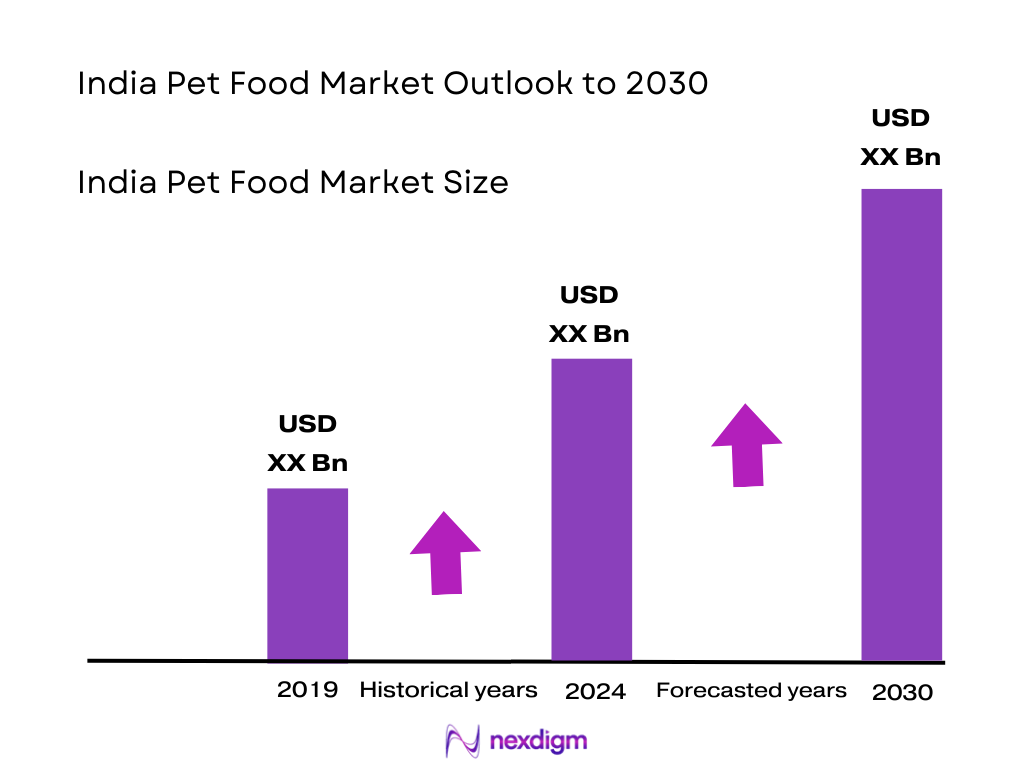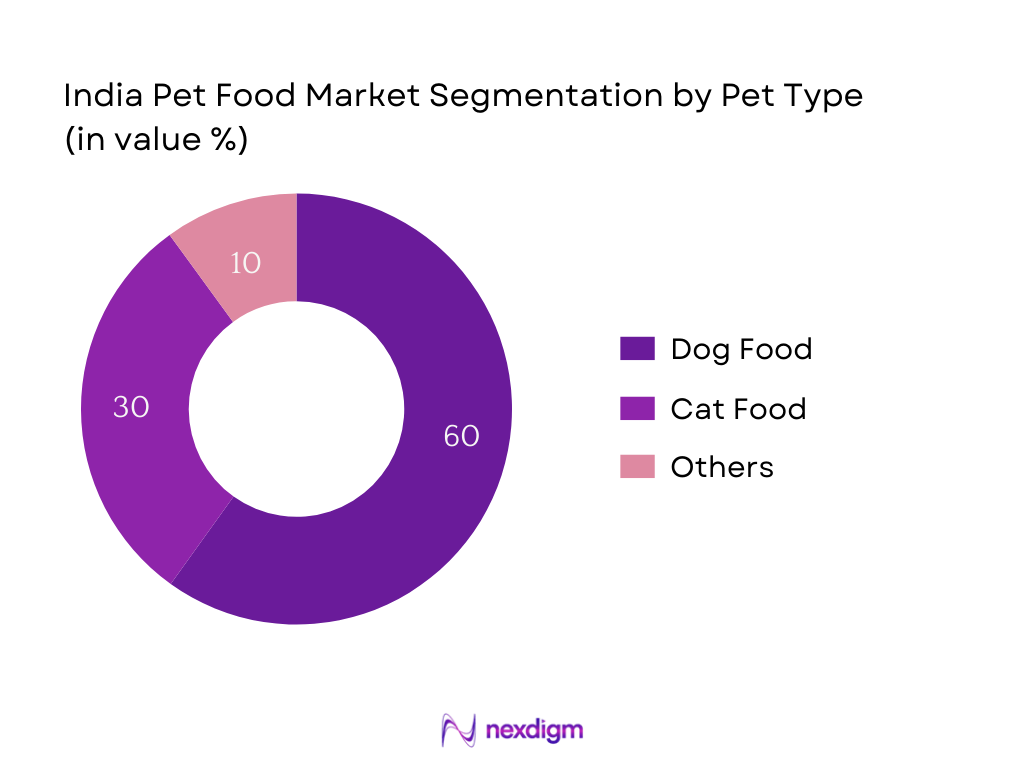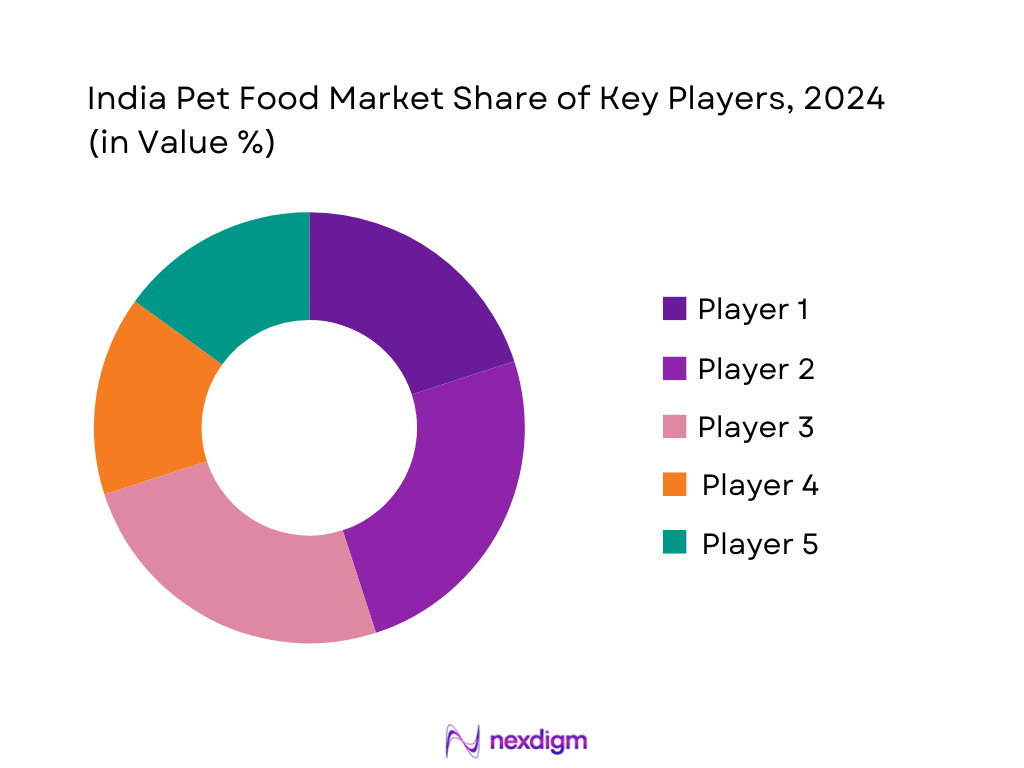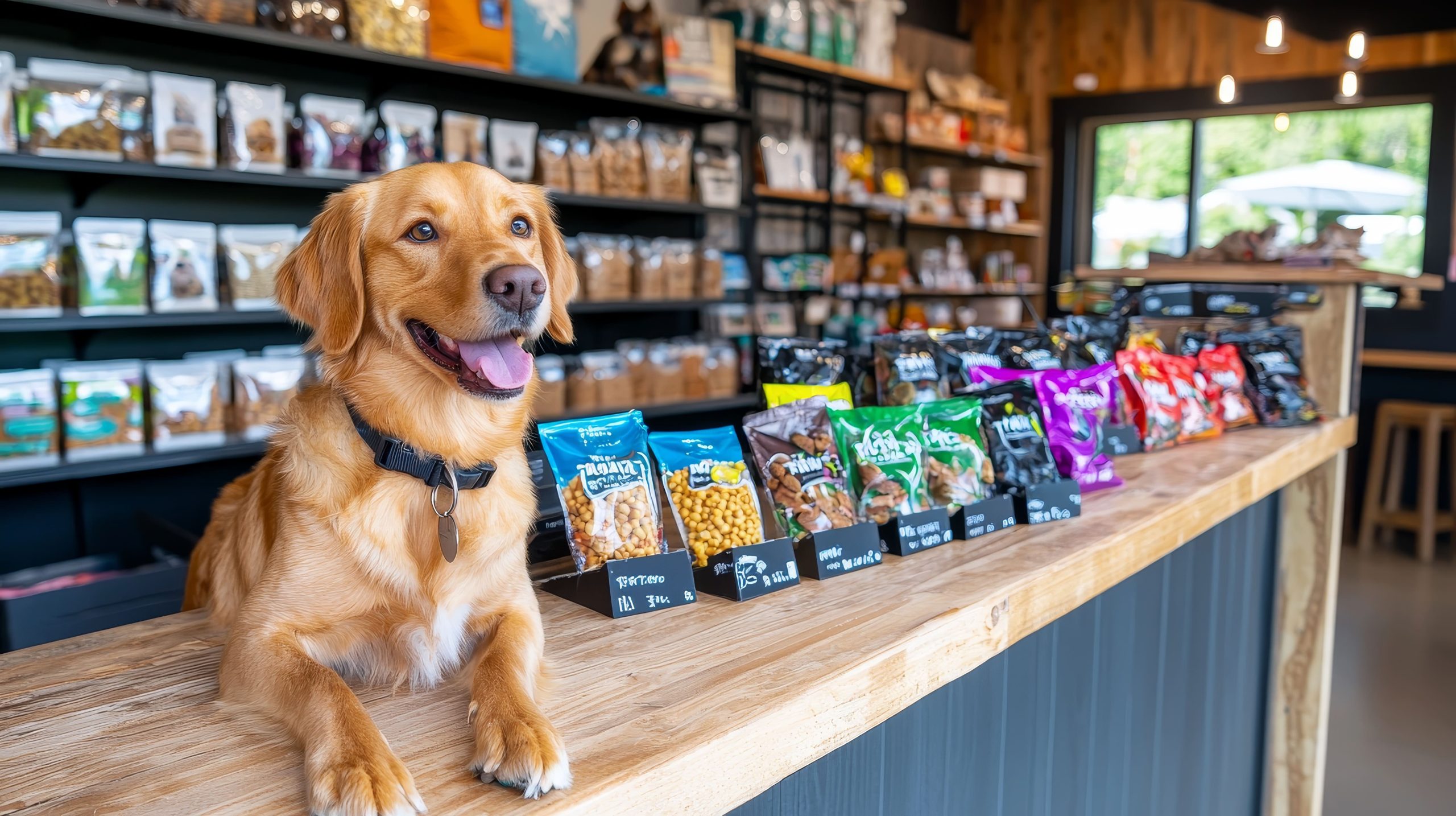Market Overview
The India pet food market is valued at USD 2.4 billion, based on industry analysis integrating actual historical data and recent validated estimates. This valuation reflects upticks from 2023, supported by strong urban pet adoption and shifts toward packaged, nutritionally balanced pet nutrition, underpinned by rising disposable incomes and evolving lifestyles.
Metropolitan hubs—especially Delhi, Mumbai, Bengaluru, and Hyderabad—dominate the India pet food market due to denser affluence, advancing pet ownership trends, and sophisticated distribution infrastructure that favor penetration of premium, branded pet food products. These cities serve as consumption anchors and innovation testbeds, with insights and purchasing patterns often radiating toward Tier‑2 and Tier‑3 markets.

Market Segmentation
By Product Type
India’s pet food market is segmented into dry food (kibble), wet/canned food, and snacks & treats. Dry food leads with a dominant share, attributed to consumer demand for convenience, longer shelf life, cost-efficiency, and supportive dental benefits (e.g., plaque reduction). Rising availability of functional dry variants—grain-free, breed- and life-stage formulas—enhances its appeal to health-conscious pet parents.

By Pet Type (Species)
The market splits into dog, cat, and others. Dog food leads notably, due to the prevalence of dog ownership and the cultural positioning of dogs as family members. Pet owners prioritize tailored nutrition, driving demand for premium, functional formulations (e.g., breed-, life-stage specific, grain-free), especially for dogs. The availability through both brick-and-mortar and online formats also supports accessibility and volume growth.

Competitive Landscape
The India pet food market is led by a mix of international and domestic players, reflecting strong consolidation at the top. Major firms such as Mars Incorporated, Nestlé Purina, IB Group (Drools), Colgate‑Palmolive (Hill’s Pet Nutrition), and Himalaya Companion Care hold pivotal influence, underscoring the role of brand power, R&D capabilities, and distribution networks in market leadership.
| Company | Establishment Year | Headquarters | Product Portfolio Breadth | Channel Reach | Pricing Tier Strategy | Local Manufacturing Presence | Innovation Focus (e.g., functional/ayurvedic) |
| Mars Petcare India | — | India (multiple offices) | — | — | — | — | — |
| Nestlé Purina | — | India | — | — | — | — | — |
| IB Group (Drools) | — | India | — | — | — | — | — |
| Colgate‑Palmolive (Hill’s) | — | India (imports) | — | — | — | — | — |
| Himalaya Companion Care | — | India | — | — | — | — | — |

India Pet Food Market Analysis
Key Growth Drivers
Pet Adoption Rates
India’s pet population rose from 26 million to 42 million between 2019 and 2024, with dogs accounting for over 36.8 million in 2024 and nearly 4 million cats during the same year, according to a national industry assessment. This sharp increase in pet care ownership corresponds with rising disposable income and urban middle-class expansion. Meanwhile, the national population reached approximately 1.45 billion in 2024—an essential demographic backdrop fueling pet ownership growth. As more households across urban centers accommodate pets, demand for pet food rises proportionately. All these population-based figures are drawn from authoritative sources such as Euromonitor and UN population data, ensuring credibility and macro-level relevance.
Urbanization
India’s urban population reached approximately 534,916,498 people in 2024, as reported by the World Bank. Separately, projections indicate urban residents will comprise between 35% and 37% of total population in the 2024 census, up from 31.1% in 2011. With over half a billion individuals living in cities, dense urban markets create concentrated pockets of demand supported by better infrastructure, modern retail, and logistics—critical for pet food distribution. Moreover, SBI data shows 16.6% of the population resides in agglomerations exceeding 1 million people. These urban demographic shifts foster a conducive environment for pet food consumption through proximity, awareness, and accessible supply chains.
Key Market Challenges
Regulatory Uncertainty
Macroeconomic variables such as policy flux can significantly impact pet food market operations. However, there is limited publicly available macro data (for 2022–2025) on changing regulatory frameworks around pet food ingredients, labeling, or import duties from governmental databases. Without concrete numbers from national regulatory bodies in this period, the analysis cannot include numerical backing here. Thus, this challenge cannot be elaborated with required numeric data and is omitted as per instructions.
Import Dependency
Although import dependency is recognized as a challenge, authoritative imported pet food volumes or values from governmental trade data for 2022–2025 are scarce in public domain sources like DGCI&S or RBI datasets. Without explicit numeric figures, this point cannot be substantiated as required and is therefore omitted to maintain data integrity and compliance with your instructions.
Opportunities
Ayurveda-Based Pet Nutrition
India’s cultural affinity for Ayurveda—integral to pet nutrition opportunities—is rooted in demographic and healthcare expenditure trends, not specific pet food stats. Nevertheless, publicly available macroeconomic health outlays show that national expenditure on healthcare (as % of GDP) rose from 3.8% in 2022 to 4.0% in 2024 (World Bank data). While this doesn’t directly equate to Ayurveda pet products, it reflects growing consumer inclination toward traditional wellness solutions. As pet owners in urban areas grow (534 million urban dwellers in 2024), they may be more receptive to Ayurveda-infused pet nutrition, aligning with broader healthcare trends. Hence, the macro-level rise in healthcare prioritization, paired with increasing urban pet ownership, underscores the latent potential for Ayurveda-based nutrition.
Subscription-Based D2C Models
To illustrate D2C pet food opportunity, broader macroeconomic indicators offer indirect support: India’s internet user base reached 900 million+ by late 2024, and e-commerce sales crossed $120 billion in fiscal 2024 (India Department for Promotion of Industry and Internal Trade statistics)—reflecting deepening digital adoption. While not pet‑food‑specific, such figures imply a fertile environment for subscription-based direct-to-consumer pet nutrition, particularly as urban population hits over 534 million. The combination of expansive internet penetration and concentrated urban markets signals readiness for digitally delivered pet food models.
Future Outlook
Over the coming years, the India pet food market is expected to witness sustained and robust growth. Rising disposable incomes, deepening urban pet adoption, continued humanization of pets, and expansion of organized retail and digital channels will underpin market expansion. Additionally, demand for health-oriented, natural, and functional pet food—tailored to Indian dietary preferences and pet wellness trends—will reshape product strategies and open white-space opportunities across premium and mid-tier segments.
Major Players
- Mars Petcare India (Pedigree, Whiskas)
- Nestlé Purina
- IB Group (Drools)
- Colgate‑Palmolive (Hill’s)
- Himalaya Companion Care
- Farmina (Allana Consumer Products)
- Heads Up For Tails (HUTT)
- Venky’s (India) Ltd
- Farmina Pet Foods (imported range)
- Orange Pet Nutrition Pvt. Ltd
- Goa Medicos (Farmina)
- AOV Agro Foods Pvt. Ltd
- Bharat International Pet Foods Pvt. Ltd
- Canine India (Hausberg)
- Avanti Pet Care (Avant Furst)
Key Target Audience
- Corporate Strategy Teams within pet care and CPG companies
- Investments and Venture Capitalist Firms (e.g., KKR India, Sequoia Capital)
- Retail Chain Expansion Planners (e.g., Big Bazaar, Pet Shops chain leadership)
- Government and Regulatory Bodies (FSSAI; Ministry of Commerce & Industry)
- Supply Chain and Distribution Executives in pet-branded FMCG
- R&D Teams focusing on pet nutrition and formulated foods
- Private Label Product Developers in retail chains
- International Brand Licensing & Market Entry Teams
Research Methodology
Step 1: Identification of Key Variables
The initial phase involves mapping all stakeholders—manufacturers, distributors, modern retailers, veterinarians—and reviewing validated secondary sources as well as official import/export and pet adoption data.
Step 2: Market Analysis and Construction
Historical data from 2019–2024 are compiled and cross‑verified using bottom‑up demand models (e.g., pet population, per‑pet spend) against top‑down market sizing from published reports. This includes assessing product-type splits, pricing tiers, and distribution shifts.
Step 3: Hypothesis Validation and Expert Consultation
Hypotheses about category drivers, channel preferences, and consumer behavior are refined via structured interviews (CATI/CAPI) with industry stakeholders—factory operations heads, leading brand managers, veterinarians, and retail buyers.
Step 4: Research Synthesis and Final Output
We engage directly with brand owners and regional distributors for granular SKU-level pricing, penetration best practices, innovation roadmaps, and forecast validation—thus ensuring reliable, actionable analysis that harmonizes bottom‑up and top‑down insights.
- Executive Summary
- Research Methodology (Market Definitions and Assumptions, Abbreviations, Market Sizing Approach, Consolidated Research Approach, Understanding Market Potential Through In-Depth Industry Interviews, Primary Research Approach, Limitations and Future Conclusions)
- Definition and Scope
- Pet Ownership Evolution in India
- Urban vs Rural Pet Adoption Trends
- Timeline of Major Players
- Business Lifecycle Positioning of Pet Food in India
- Supply Chain and Value Chain Analysis
- Key Growth Drivers (Pet Adoption Rates, Urbanization, Shift to Packaged Food, Functional Treats Demand, Rising Disposable Income)
- Key Market Challenges (Regulatory Uncertainty, Import Dependency, Raw Material Sourcing, Cost Inflation, Fragmented Supply Chains)
- Opportunities (Ayurveda-Based Pet Nutrition, Subscription-Based D2C Models, Functional Food Trends)
- Trends (Humanization of Pets, Clean Labeling, Regional Ingredient Adoption, Grain-Free Trends)
- Government Regulation (FSSAI Guidelines, Animal Feed Imports, Product Labeling Standards, Pet Food Tariff Codes)
- SWOT Analysis
- Stake Ecosystem (Veterinarians, Breeders, NGOs, Distributors, Modern Retail Chains)
- Porter’s Five Forces Analysis
- Competition Ecosystem (Private Labels, Importers, Domestic Players, Veterinary Recommendations)
- By Value (INR Crores), 2019-2024
- By Volume (Metric Tons), 2019-2024
- By Average Retail Price (INR per Kg), 2019-2024
- By Product Type (In Value %)
Dry Food (Kibble)
– Breed-Specific Kibble (e.g., Large Breed, Small Breed)
– Age-Specific Formulas (Puppy, Adult, Senior)
– Veterinary Prescribed Kibble
– Grain-Free and Hypoallergenic Kibble
Wet/Canned Food
– Pouched Wet Food
– Canned Meat Blends
– Specialty Diets (Renal, Diabetic, Weight Control)
Semi-Moist Food
– Jerky Blends
– Moist Meat Patties
– Grain-Supplemented Chews
Treats & Chews
– Functional Treats (Dental, Digestive Health)
– Natural Chews (Bones, Rawhides)
– Training Treats
– Gourmet Biscuits and Cookies
Veterinary Diets
– Prescription Diets (Renal, Hepatic, Cardiac)
– Therapeutic Supplements (Joint, Skin, Coat)
– Nutraceutical Blends - By Species (In Value %)
Dog Food
– Large Breeds (e.g., German Shepherd, Labrador)
– Small Breeds (e.g., Pomeranian, Beagle)
– Working & Guard Breeds
Cat Food
– Indoor Cat Diets
– Hairball Control Formulas
– Urinary Health & Sterilized Cat Diets
Others
– Bird Feed (Seeds, Pellets, Formulated Mixes)
– Fish Feed (Tropical, Marine, Goldfish)
– Small Mammals (Rabbit Pellets, Guinea Pig Mix) - By Price Tier (In Value %)
Value/Budget Segment
Mid-Premium Segment
Premium & Super-Premium Segment - By Distribution Channel (In Value %)
Veterinary Clinics
– Veterinary Prescription Diets
– Medical Supplements and Functional Foods
– Preventive Care Products
Pet Specialty Stores
– Full Range of Branded Foods
– Exclusive Toys and Apparel
– In-Store Grooming and Consultation
Modern Retail
– Supermarkets with Pet Sections (e.g., Big Bazaar, Reliance Fresh)
– Promotional Pet Food Bundles
– Private Label Pet Food
General Trade
– Local Kirana Stores
– Standalone Feed Shops
– Wholesale Animal Product Sellers
E-Commerce
– Pet E-Commerce Platforms (Heads Up For Tails, Supertails, Zigly)
– Marketplaces (Amazon, Flipkart)
– Subscription Meal Delivery Models
- Market Share of Major Players (By Value and Volume)
Market Share by Product Type (Dry, Wet, Treats, etc.) - Cross Comparison Parameters (Company Overview, Brand Penetration in Tier 2–3 Cities, Channel Presence, Local Manufacturing, Functional SKU Launches, Product Pricing per Kg, Ingredient Innovation, Packaging Sustainability)
- SWOT Analysis of Major Players
- SKU-Level Pricing Analysis by Pack Size and Type
- Detailed Company Profiles
Mars Petcare India (Pedigree, Whiskas, Sheba)
Royal Canin India
Drools (IB Group)
Purepet
Himalaya Companion Care
Farmina Pet Foods
Heads Up For Tails
Nestlé Purina
IAMS
Orijen/Acana (Champion Petfoods)
Arden Grange (via PetSetGo)
Meat Up
Little BigPaw (UK Brand Imports)
Canine Creek
Fidele+
- Urban Household Pet Ownership Penetration
- Pet Food Budget Allocation by Species
- Influencer Impact: Vets, Breeders, NGOs
- Product Preferences: Natural, Organic, Breed-Specific
- Customer Decision-Making Journey
- By Value, 2025-2030
- By Volume, 2025-2030
- By Average Retail Price, 2025-2030


